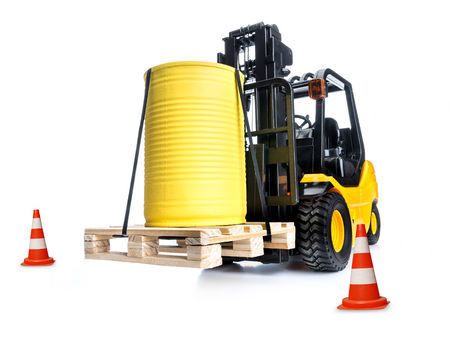Storage and Handling
Containers
Proper storage and handling of flammable and combustible liquids will help prevent fires from occurring; only approved, closed containers for storage of flammable or combustible liquids may be used under OSHA rules. Such containers include safety cans or containers approved by the U.S. Department of Transportation.

A safety can is a container that has a self-closing lid, internal-pressure relief, and flame arrestor with a capacity of not more than 5 gallons. Inexpensive, plastic cans are not approved for use in roofing operations. However, manufacturers do sell plastic containers that meet the OSHA requirements for safety cans.
Flammable liquids that are extremely viscous, or difficult to pour, like single ply adhesive, can be left in their original shipping containers. Similarly, OSHA allows the use of original containers of flammable liquids that are in quantities of one gallon or less.
Cabinets
Safety cabinets allow for greater quantities of flammable and combustible liquids to be stored safely inside buildings. Up to 60 gallons of a flammable liquid or as much as 120 gallons of a combustible liquid may be stored indoors in a safety cabinet. Each cabinet must be labeled "Flammable-Keep Fire Away." Up to three cabinets may be stored in one room. Without a safety cabinet, only 25 gallons of either flammable or combustible liquids are allowed to be stored inside a building.
Static Electricity
Static electricity may be generated when transferring liquids, gases, or solids through pipes or hoses. It is important to dissipate this electric charge when handling flammable and combustible materials. When transferring flammable or combustible liquids from one container to another, the two containers must be "bonded" together. The bonding process involves attaching a wire with alligator clips on each end to both containers. The clips must penetrate the container coating and touch metal. You may need to score the paint with the alligator clips.
To dissipate static electricity, the container receiving the liquid must be in contact with the ground and not insulated from contact with the ground. For example, plastic or composite pickup truck bed liners prevent the flow of static electricity to ground because the liner does not conduct electricity. The receptacle container must have a clear path to ground, by direct contact or use of a grounding strap or wire, to effectively eliminate static.
Knowledge Check Choose the best answer for the question.
2-4. What is the maximum amount of flammable liquid that can be stored indoors in a safety cabinet?
You forgot to answer the question!
